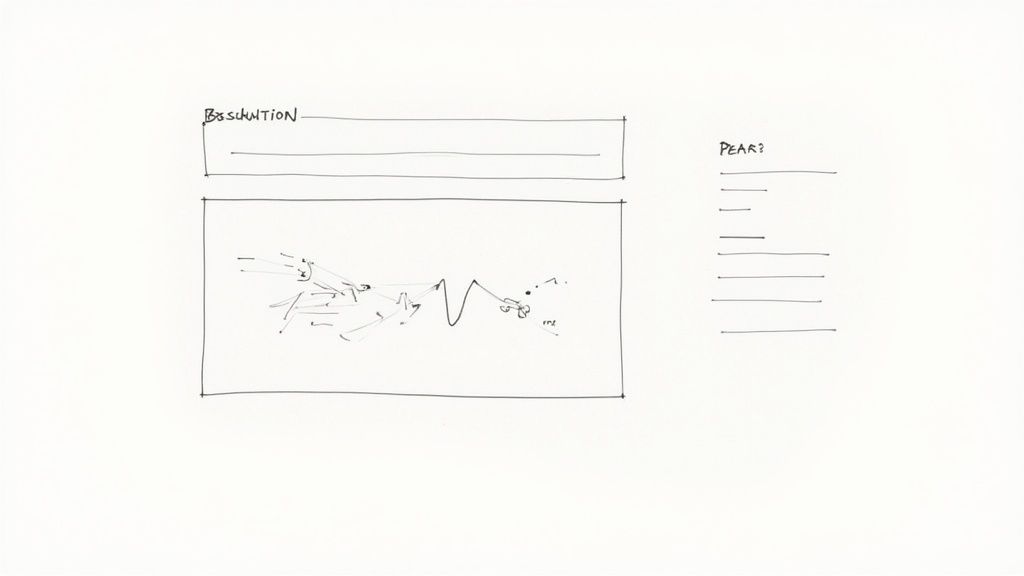How to Improve Website Conversion Rate: Expert Tips

Understanding Conversion Rate: The Metric That Drives Revenue

Conversion rate is simply the percentage of website visitors who complete a desired action. This action could be anything from purchasing a product to signing up for a newsletter or downloading a resource. Understanding this metric is fundamental to improving it, and it directly impacts your bottom line. To gauge your current performance, learn how to calculate conversion rate.
Why Conversion Rate Matters
A higher conversion rate means more customers and more revenue. Even a small improvement can have a big impact. For example, increasing your conversion rate from 2% to 5% can significantly boost profitability. This leads to a more efficient marketing budget and a stronger return on investment. Prioritizing conversion rate optimization is essential for sustainable business growth. Learn more about how to master website conversion optimization.
The Impact of Small Improvements
Small changes can yield significant returns. Improving website conversion rates is particularly crucial for e-commerce businesses. For example, Walmart found that for every one-second improvement in page load time, they saw a 2% increase in conversions.
This seemingly small change can translate into substantial revenue gains. If an e-commerce site generates $10 million annually, a 2% increase equates to an extra $200,000. This highlights the importance of website speed for user experience and conversions. Faster loading also benefits SEO, bringing in more traffic. Learn more about website performance and conversion rates.
Benchmarking Your Performance
It's important to understand how your conversion rate compares to others in your industry. Different sectors have different benchmarks. E-commerce conversion rates typically average between 2% and 3%, while lead generation sites often aim for higher figures.
Benchmarking helps identify areas for improvement and set realistic goals. It allows you to tailor your strategies for maximum effectiveness. Research your industry and analyze your competitors to see how you measure up.
Accelerating Site Speed: The Foundation of Conversion Success

Understanding conversion rates and their calculation is important. But site speed is crucial for turning visitors into customers. It significantly influences whether a visitor stays and converts or leaves frustrated. Site speed is the bedrock of any successful conversion strategy. Today's users expect instant access to information. Delays can lead to missed opportunities and lost revenue.
This is why site speed matters and why you should make it a priority.
Why Every Millisecond Matters
Imagine a physical storefront. A locked door or a long wait would discourage potential customers. Your website is your digital storefront. A slow-loading site creates the same friction, signaling a lack of respect for the visitor's time. This directly impacts your bottom line. A fast website creates a positive first impression and encourages engagement.
Website speed is a critical factor in determining conversion rates. Research shows that websites loading in one second can have conversion rates five times higher than those taking 10 seconds to load. This improvement in load times boosts not only conversions but also user experience and SEO.
Even a one-second improvement can lead to a 7% rise in conversions. Loading in two seconds or less can boost them by 15%. For more detailed statistics, visit WordStream. These numbers underscore the significant impact of speed optimization.
Measuring Your Site's Speed
You can't improve what you don't measure. Several tools are available to assess your website's current performance:
- Google PageSpeed Insights: This free tool analyzes your website and provides a performance score and improvement recommendations.
- WebPageTest: Offering more in-depth analysis, including waterfall charts, WebPageTest lets you test from different locations and browsers.
- GTmetrix: GTmetrix provides performance scores, actionable recommendations, and optimization grades.
These tools help identify bottlenecks and areas needing attention. For a comprehensive guide on improving website performance, see Roast My Web.
Actionable Speed Optimization Strategies
Optimizing website speed requires a multifaceted approach. Here are some strategies for both non-developers and developers:
Quick Wins for Non-Developers
- Image Optimization: Compressing images with tools like TinyPNG or ShortPixel reduces file size without sacrificing quality, improving load times.
- Browser Caching: Enabling browser caching allows repeat visitors to load your site faster by storing static assets locally.
Advanced Techniques for Developers
- Content Delivery Network (CDN): A CDN distributes your website's content across multiple servers globally, reducing latency and improving load times for users worldwide.
- Code Minification and Optimization: Streamlining code by removing unnecessary characters optimizes performance. This involves removing unnecessary comments, whitespace, and shortening variable names.
Addressing these areas and consistently monitoring progress will positively impact your site speed and conversion rates. Learn more about mastering website performance from Roast My Web. Each optimization contributes to a smoother, faster, and more engaging user experience, increasing the likelihood of conversions.
Crafting CTAs That Convert: Beyond the "Submit" Button

Optimizing site speed is essential for a positive user experience. But even the fastest websites won't generate conversions without effective calls-to-action (CTAs). Think of CTAs as the bridge connecting user interest with the actions you want them to take. They guide visitors toward conversion. A poorly designed CTA can significantly hinder this process.
The Psychology of Clickable Buttons
Effective CTAs are more than just attractive buttons. They leverage the psychology of persuasion. Color psychology, for instance, plays a vital role. While no single color is universally "best," A/B testing reveals that certain colors perform better with specific audiences. A vibrant green might appeal to environmentally conscious consumers, while a bold orange can instill a sense of urgency.
Button placement is equally important. Eye-tracking studies demonstrate predictable user scanning patterns on web pages. Positioning your CTAs along these paths enhances visibility and click-through rate. Strategically place CTAs within the user's natural gaze, not hidden in corners or buried in clutter.
CTA Copy That Compels
The wording of your CTAs has a significant impact. Generic phrases like "Submit" or "Click Here" are less effective than action-oriented copy that highlights benefits. Using phrases such as "Get Your Free Guide" or "Start Your Free Trial" creates a sense of value and encourages immediate action.
Adding a touch of urgency, without being manipulative, can also boost conversions. Phrases like "Limited-Time Offer" or "Download Now" create scarcity and motivate users to act quickly.
To illustrate the various approaches, let's look at a comparison of different CTA styles and their performance.
CTA Performance Comparison by Style This table presents conversion rate data comparing different CTA styles, helping readers understand which approaches tend to perform best.
| CTA Style | Average Conversion Rate | Best Use Case | Example Copy |
|---|---|---|---|
| Button with Benefit-Driven Copy | Higher (e.g., 5-10%) | Encouraging specific actions with clear value proposition | "Download Your Free eBook Now" |
| Text-Based CTA with Urgency | Moderate (e.g., 3-5%) | Driving immediate action for time-sensitive offers | "Last Chance: Enroll Today!" |
| Simple Button with Action Verb | Lower (e.g., 1-3%) | Basic actions with less emphasis on benefits | "Learn More" |
| Image-Based CTA | Varies widely | Visually appealing offers, often product-focused | Image of product with "Shop Now" overlay |
As you can see, benefit-driven CTAs often yield the highest conversion rates, while simple buttons tend to perform less well. Image-based CTAs offer a unique visual approach, but their performance can be unpredictable.
A/B Testing Your CTAs
Even with best practices, optimizing CTAs requires A/B testing. This involves creating two versions of a CTA with slight variations in color, copy, or placement. Showing each version to a segment of your audience reveals which performs better. Further information on this topic can be found in our article about landing page best practices.
Small changes can have significant effects. One company achieved a 104% increase in conversions by changing a few words in their CTA, highlighting the importance of data-driven optimization.
Customizing CTAs for Different Audiences
Remember, your audience isn't uniform. Different segments respond differently to various CTAs. Tailoring CTAs to specific audience segments and their position in the buyer journey improves website conversion rates. A first-time visitor might respond well to a free resource download, while a returning visitor might be more inclined to click on a product demo.
Eliminating Form Friction: Where Conversions Are Won or Lost

Attractive calls to action (CTAs) are essential for drawing users in. However, they're only as effective as the forms they lead to. Forms are the point where potential customers provide their valuable information, making them a crucial part of the conversion process. But poorly designed forms create friction, leading to form abandonment and lost opportunities. This section explores how to transform your forms from obstacles into conversion gateways.
Optimal Field Count: Less Is More
One of the most common form design mistakes is asking for too much information upfront. Imagine meeting someone for the first time and immediately bombarding them with questions. The same principle applies to online forms. Conversion Rate Optimization (CRO) strategies are critical for maximizing the return on website traffic. Research shows the average global e-commerce conversion rate hovers around 2.86%, while top performers can exceed 11.45%. More detailed statistics can be found here.
This data reinforces the need to optimize every aspect of the user experience, starting with your forms. Simplifying forms by reducing the number of fields can significantly increase conversions. Often, forms with just three fields achieve considerably higher conversion rates.
To illustrate this further, let's look at the impact of form length on conversion rates across various industries:
Impact of Form Length on Conversion Rates
This table shows how the number of form fields affects conversion rates across different industries.
| Number of Fields | Average Conversion Rate | Abandonment Rate | Industry Differences |
|---|---|---|---|
| 3-5 | High (e.g., 10-15%) | Low | Simpler forms tend to perform well across industries, especially for lead generation. |
| 6-10 | Moderate (e.g., 5-9%) | Moderate | E-commerce sites often require more fields for shipping and billing, potentially impacting conversion rates. |
| 11+ | Low (e.g., <5%) | High | Complex forms, such as registrations or applications, generally see lower conversion rates and higher abandonment. |
As you can see, the number of form fields directly correlates to conversion success. Shorter forms generally lead to higher conversion rates and lower abandonment.
Inline Validation: Guiding Users Towards Completion
Inline validation offers real-time feedback as users fill out forms. Instead of waiting until submission to reveal errors, inline validation flags issues instantly. This prevents frustration and guides users towards correct input, dramatically improving completion rates. It creates a smoother, more positive experience.
Progressive Disclosure: Unveiling Information Gradually
For complex forms, progressive disclosure is a game-changer. This method breaks the form into smaller, manageable steps, only revealing the next section once the previous one is completed. This approach avoids overwhelming users with a long list of fields and encourages completion. It's particularly useful for e-commerce checkouts or lead generation forms requiring detailed information.
E-commerce Checkout Optimization: From Cart to Conversion
The checkout process is the final hurdle to conversion for e-commerce sites. A streamlined, user-friendly experience is paramount. Key considerations include:
- Counteracting Cart Abandonment: Abandoned carts represent lost sales. Strategies like reminder emails or discounts can recapture these potential customers.
- Frictionless Guest Checkout: Allowing guest checkout removes a significant barrier, especially for first-time buyers.
- Mobile Form Optimization: Ensure forms are responsive and optimized for mobile users.
Form Analytics: Identifying Your Specific Roadblocks
To truly optimize forms, data is essential. Implementing form analytics, such as through tools like Hotjar or Google Analytics, allows you to identify where users abandon the process, which fields cause confusion, and how long completion takes. Analyzing this data pinpoints friction points, paving the way for targeted improvements and boosting your website's conversion rate.
Leveraging Social Proof: Building Trust That Drives Action
Streamlining your online forms is essential, but building trust is paramount for boosting conversions. In the online world, establishing credibility is crucial for overcoming visitor hesitation and encouraging them to take the next step. This section explores the power of social proof and its significant impact on website conversion rates.
Understanding the Power of Social Proof
Consider how you make decisions. Are you more likely to try a restaurant with glowing reviews or one with no feedback? This natural tendency to follow the crowd is what makes social proof so effective. It taps into the human desire for validation and makes potential customers feel more comfortable making a purchase or sharing their information.
For example, one travel company saw a 104% increase in conversions simply by incorporating social proof into their call to action. This highlights the significant influence of trust on visitor behavior.
Types of Social Proof That Convert
Several types of social proof can be strategically used to boost your website conversion rate:
- Customer Reviews and Testimonials: Authentic feedback from satisfied customers is invaluable. Displaying these prominently can reassure potential buyers and address their concerns.
- Case Studies: Addressing specific objections through detailed case studies provides concrete evidence of your product or service’s effectiveness. This is particularly persuasive for complex purchases.
- Security Credentials and Trust Badges: Displaying recognized security seals and trust badges, such as McAfee Secure or the Better Business Bureau logo, builds confidence in your website’s safety and legitimacy.
- Authority Signals: Featuring endorsements from industry experts or showcasing awards and recognitions reinforces your expertise.
- Social Media Shares and Followers: A robust social media presence signals popularity and further validates your brand.
Collecting and Displaying Social Proof
Collecting authentic social proof requires a proactive approach:
- Actively Solicit Feedback: Request reviews and testimonials directly from your customers. Consider offering incentives to encourage participation.
- Showcase Authentic Voices: Use real customer photos and full names (with permission) to increase testimonial credibility.
- Strategic Placement: Position social proof elements near calls to action and areas where visitors might hesitate, such as pricing pages or checkout forms.
Ethical Considerations: Scarcity and Popularity
While displaying popularity indicators like "97 people are viewing this item right now" can create urgency, use these tactics ethically. Manufactured scarcity or exaggerated popularity can erode trust and harm your brand reputation. Transparency and honesty are crucial for building genuine trust.
By strategically leveraging social proof and building trust, you can transform hesitant visitors into confident customers, ultimately driving a substantial improvement in your website conversion rate.
Mastering A/B Testing: From Guesswork to Growth Engine
A/B testing empowers data-informed decisions, shifting conversion rate optimization from guesswork to a strategic growth engine. By testing variations of web pages, you discover what resonates with your audience, leading to higher conversion rates. This section explains how to leverage A/B testing effectively for website improvement.
Designing Effective A/B Tests
Effective A/B testing goes beyond simply running tests; it involves designing experiments that yield meaningful insights. This requires careful selection of test elements and a clear hypothesis.
-
Hypothesis Formulation: Begin by formulating a hypothesis grounded in user behavior analytics data. For example, if analytics show high bounce rates on a specific landing page, your hypothesis could be that changing the headline will improve engagement.
-
Variable Isolation: Concentrate on testing one element at a time. If you want to test both a headline and a call to action, conduct separate tests. This isolates the impact of each change on conversion rates.
Prioritizing Your Testing Opportunities
Not all tests are equally valuable. Frameworks like PIE (Potential, Importance, Ease) and ICE (Impact, Confidence, Ease) help prioritize tests.
-
PIE Framework: Score potential tests based on their potential impact, importance to business objectives, and ease of implementation. Prioritize high PIE scores.
-
ICE Framework: Similar to PIE, ICE evaluates tests on potential impact, your confidence in the hypothesis, and ease of implementation. Prioritize high ICE scores.
-
Example: Consider testing your call-to-action button color versus rewriting your entire landing page. The button color test will likely have a higher ease score in both PIE and ICE due to simpler implementation.
Implementing and Analyzing A/B Tests
Understanding sample size, test duration, and statistical significance is crucial for accurate conclusions.
-
Sample Size: Larger sample sizes yield more reliable results. Use a sample size calculator to determine the appropriate number of participants, ensuring statistical significance.
-
Test Duration: Run tests long enough to account for user behavior fluctuations. Avoid premature conclusions.
-
Statistical Significance: Aim for statistically significant results, typically a p-value of 0.05 or lower. This signifies 95% confidence that observed changes are not random.
-
Tools: Numerous A/B testing platforms exist, catering to different budgets and complexities. Google Optimize offers free basic functionality, while premium platforms like Optimizely provide advanced features.
By mastering these A/B testing elements, you can transform your website into a conversion powerhouse, continually optimizing its effectiveness. Transition from guesswork to data-driven decisions that maximize results.
Analytics That Drive Action: Finding Your Conversion Leaks
Improving your website’s conversion rate depends significantly on understanding how users interact with your site. This means going beyond superficial metrics like pageviews and delving into the data that reveals why visitors aren't converting. The first step is setting up comprehensive conversion tracking, capturing the customer journey from their initial engagement to, ideally, a completed purchase or sign-up.
Identifying Friction Points With User Behavior Analytics
Imagine your website as a brick-and-mortar store. You wouldn't simply count the number of people entering; you'd also observe their movement through the aisles, the products they examine, and any obstacles encountered. Similarly, tools like heatmaps, session recordings, and user flow reports offer valuable insights into the digital customer experience.
-
Heatmaps visually represent where users click, scroll, and move their mouse. They highlight areas of interest and potential usability issues. For example, a heatmap might reveal users consistently clicking a non-clickable element, indicating a design flaw.
-
Session recordings are like watching security camera footage. They allow you to replay individual user sessions, observing their real-time interactions with your website. This can uncover unexpected navigation patterns or points of frustration.
-
User flow reports visualize the paths users take through your site. They identify drop-off points and bottlenecks in the conversion funnel. For instance, you might discover that many users abandon their carts during checkout, suggesting optimization needs in that area.
Combining Quantitative and Qualitative Data
Quantitative data provides a valuable overview, while qualitative insights add depth and context. Data tells you what is happening, but user testing tells you why. Combining these approaches provides a complete understanding of your conversion roadblocks.
For example, user testing might reveal that users understand your product's value but find the checkout process confusing. This qualitative insight complements the quantitative data from user flow reports, highlighting the need for clearer instructions or a simplified checkout design.
Establishing Meaningful KPIs and Prioritizing Optimization
Simply focusing on the overall conversion rate isn't sufficient. Establish key performance indicators (KPIs) specific to different stages of the conversion funnel. These might include metrics like:
- Landing page conversion rate
- Cart abandonment rate
- Form completion rate
By tracking these KPIs, you can pinpoint areas for improvement and develop a prioritized optimization roadmap based on data, not guesswork. This allows you to allocate resources effectively and achieve maximum impact.
Ready to transform your website into a high-converting machine? Roast My Web offers AI-powered website auditing that identifies conversion bottlenecks and provides actionable insights to improve your results. Learn more about how Roast My Web can help you optimize your website for conversions.